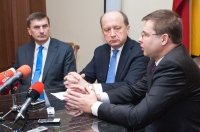The prime ministers of Estonia, Latvia and Lithuania have reaffirmed their commitment to build a new nuclear power plant serving the Baltic states and have promised to work together to make sure progress is maintained.
 |
| Baltic PMs converse (Image: BFL/Tomo Lukšio) |
Prime ministers Andrus Ansip (Estonia), Valdis Dombrovskis (Latvia) and Andrius Kubilius (Lithuania) confirmed their support for the construction of the Visaginas plant at a two-day meeting in Prienai, Lithuania. The meeting was also attended by representatives from Hitachi-GE, the strategic investor in the project, and from the European Commission.
The prime ministerial trio formally welcomed progress since their last gathering in November 2011, and went on to reaffirm their support for Visaginas "for the security of power supply in our countries" and for the three energy companies involved in the project – Eesti Energia, Latvenergo and Visagino Atominė Elektrinė (VAE). The ministers said they would be encouraging the companies to finalise negotiations in a "timely manner" to ensure that the next milestone for the project - approval of a nuclear plant concession agreement by the Lithuanian parliament - is met by June 2012.
Two Soviet-era RBMK nuclear reactors at Ignalina in Lithuania were forced to close as a condition of Lithuania's accession to the European Union, leaving the region heavily dependent on electricity imports. The planned new Visaginas plant would give the countries the chance to diversify their energy portfolio and ensure greater energy security: at present Lithuania imports almost 90% of its gas from Russia.
Hitachi-GE was announced as the project's strategic investor in June 2011, when its proposal for a 1350 MWe Advanced Boiling Water Reactor (ABWR) was selected for the Visaginas site adjacent to the closed Igalina plant. The ministers said they would also be seeking funding for the project from European financial institutions.
Estonian prime minister Ansip noted at the meeting that profitability and hedging of risks will be of vital importance in final investment decisions, and exhorted Hitachi and the three participating energy firms to determine expected rates of return and expected investment amounts as accurately as possible. "The primary precondition for the project is that the risks to be assumed by the participants would be proportional to the benefits obtained from the project. After resolving these topics, the decisions for taking monetary obligations can be made," he said.
Door still open for Poland
Estonia, Latvia and Lithuania had originally been joined in the Visaginas project by Poland, but December 2011 saw Polish utility Polska Grupa Energetyczna (PGE) withdraw from the project. Nonetheless, the prime ministers expressed their willingness to "maintain an open opportunity" for PGE to participate. PGE is pursuing plans to build a nuclear power plant in Poland.
The Baltic region's electricity supply is a hotly contested market. The Baltic states themselves enjoy good grid interconnections dating back to the Soviet era. Further grid connections are now expanding the potential for power exports - and imports - for the region. The Estlink 1 interconnector between Estonia and Finland was inaugurated at the end of 2006 and provided the first interconnection between the Nordic and Baltic energy markets, and further interconnectors between the Baltic states, Poland and Sweden are planned.
Construction work on Visaginas is envisaged as beginning around 2014, with operation in 2020-2021. However, the plant will find itself facing competition from Russia's Baltic nuclear power plant. Work is already underway on the first of two VVER 1200s at Kaliningrad, close to the Lithuanian border. The first of the Baltic reactors is due to enter commercial service in 2017, and the lion's share of its output is destined for export.
The prime ministerial meeting included discussions of steps to restrict the import of electricity from other countries, although decisions on the timing and extent of such measures were deferred to the ministers' next gathering.
Researched and written
by World Nuclear News







_53514_33880.jpg)




